flat tire TOYOTA C-HR 2020 Warranties & Maintenance Guides (in English)
[x] Cancel search | Manufacturer: TOYOTA, Model Year: 2020, Model line: C-HR, Model: TOYOTA C-HR 2020Pages: 260, PDF Size: 8.54 MB
Page 181 of 260

NITTO TIRE
179
loss in flexibility can lead to potential cracking and other damage to
the tire. To minimize the chances of this happening, you are advised to
follow these instructions:1.
Do not move or operate the car with these tires in conditions
below 15°F (-9°C).
2.
Avoid moving these tires in conditions below 15°F (-9°C).
3.
Before mounting and dismounting, store these tires for at least
24 hours in a temperature-controlled environment of 68°F (20°C)
or warmer.
4.
Remove these tires from the vehicle and deflate to half the normal
air-pressure during prolonged periods of non-use or storage.
Always inspect tires for signs of cracking and never use tires that
have cracked.
SPECIAL ADVICE FOR LIGHT TRUCKS
Never exceed the speed limit as indicated by the speed symbol on
the tire’s sidewall. See the chart and explanation of speed ratings in
this manual.
If you do not know the speed rating of your Nitto brand tire, contact
your Nitto dealer or Nitto Tire U.S.A. Inc. for current information.
Tires Designated As “LT” with No Speed Rating Indicated
on the Sidewall
Page 182 of 260

NITTO TIRE
180
It is not recommended that any light truck be operated at speeds in
excess of legal limits. However, if it is anticipated that sustained driving
at speeds in excess of 65 mph may be required, then the following
adjustments or recommendations should be followed:•
At speeds from 66 mph through 75 mph, cold inflation pressure
must be increased 10 psi above the recommended pressures for
the load being carried.
•
Do not exceed the maximum inflation pressure of the wheel (all
wheels have maximum allowable inflation pressures).
Replacement Tires for Light Trucks – P-Metric vs LT-Truck
Tire installers should exercise extreme caution when replacing tires on
light trucks.
The maximum load capacity stamped on the sidewall of a P-metric tire
is reduced by a factor of 1.1 when used on a light truck, a sport utilit\
y
vehicle, or a trailer.
Page 183 of 260
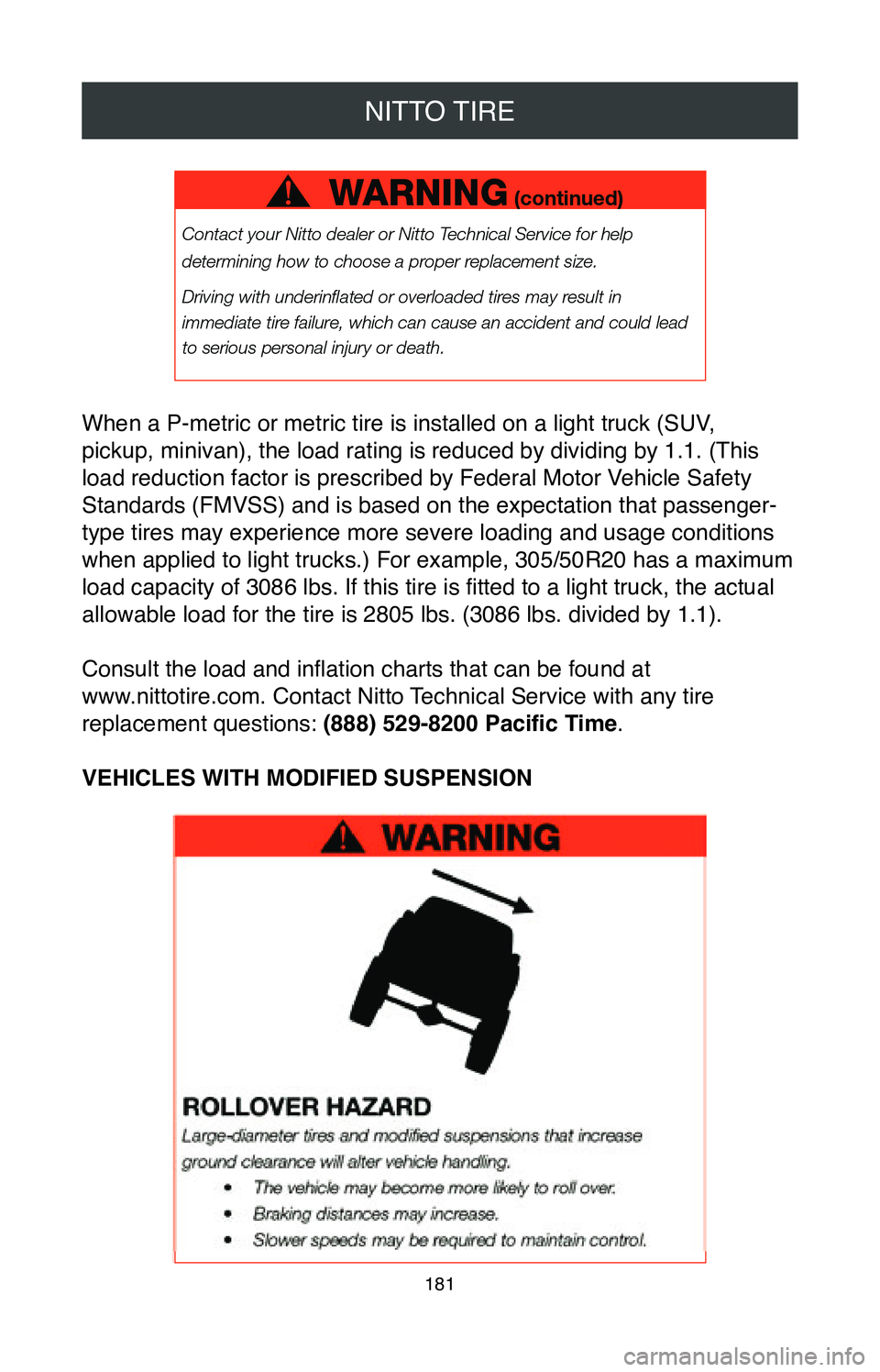
NITTO TIRE
181
When a P-metric or metric tire is installed on a light truck (SUV,
pickup, minivan), the load rating is reduced by dividing by 1.1. (This
load reduction factor is prescribed by Federal Motor Vehicle Safety
Standards (FMVSS) and is based on the expectation that passenger-
type tires may experience more severe loading and usage conditions
when applied to light trucks.) For example, 305/50R20 has a maximum
load capacity of 3086 lbs. If this tire is fitted to a light truck, the actual
allowable load for the tire is 2805 lbs. (3086 lbs. divided by 1.1).
Consult the load and inflation charts that can be found at
www.nittotire.com. Contact Nitto Technical Service with any tire
replacement questions: (888) 529-8200 Pacific Time.
VEHICLES WITH MODIFIED SUSPENSION
Page 184 of 260

NITTO TIRE
182
USEFUL TIRE INFORMATION
There is a lot of useful information molded into the sidewall of a tire.\
It shows the name of the tire, its size, if it is tubeless or tube type,\
the
maximum load and maximum inflation, and important safety warnings.
The sidewall markings on passenger and light truck tires are slightly
different.
Typical Passenger Tire
The letters “DOT” certify compliance with all applicable safety
standards established by the U.S. Department of Transportation
(DOT). Adjacent to this is a tire identification or serial number. This
serial number is a code with up to 12 digits that are a combination
Page 193 of 260
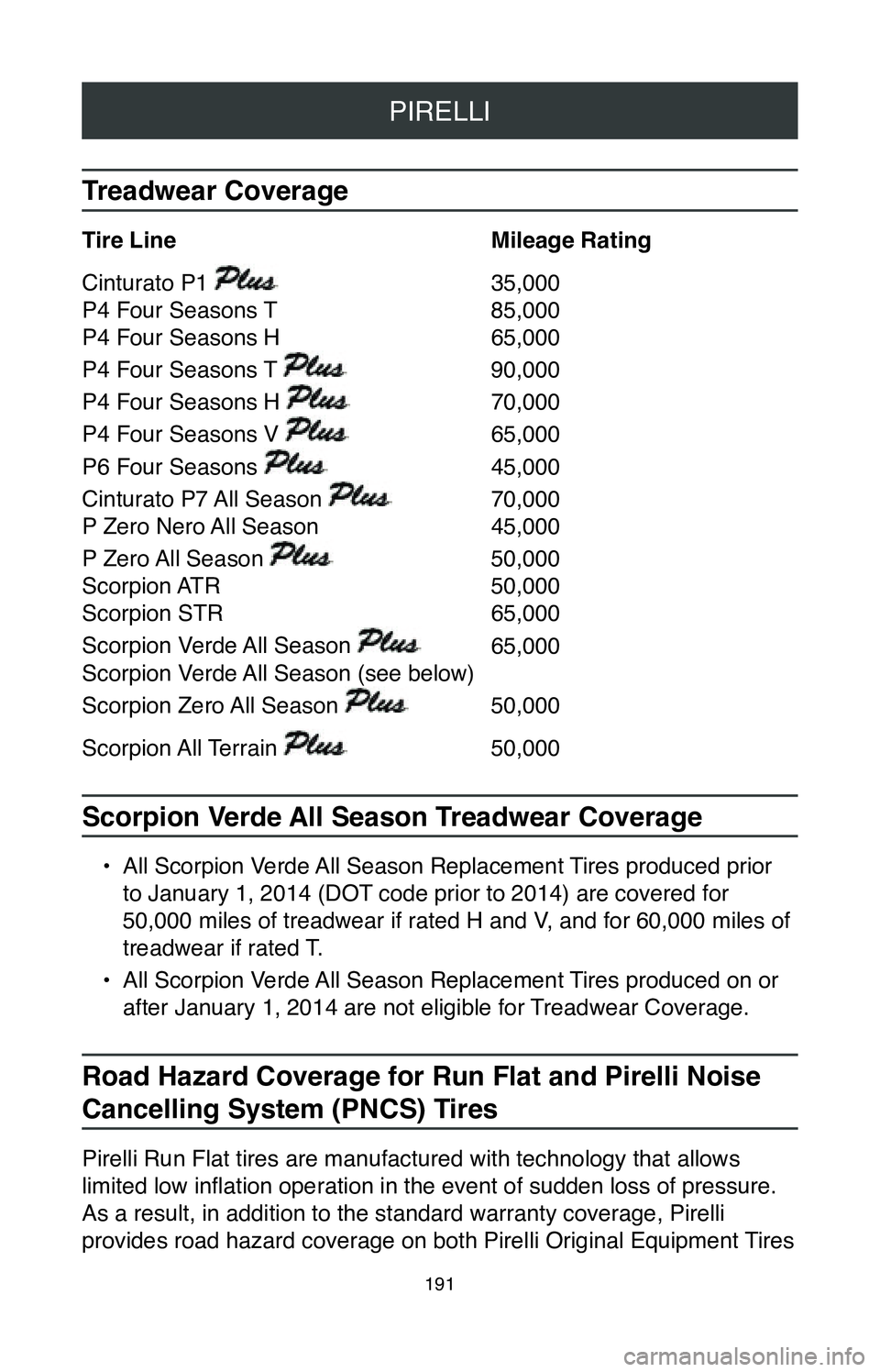
PIRELLI
191
Treadwear Coverage
Tire Line Mileage Rating
Cinturato P1
35,000
P4 Four Seasons T
85,000
P4 Four Seasons H
65,000
P4 Four Seasons T
90,000
P4 Four Seasons H
70,000
P4 Four Seasons V
65,000
P6 Four Seasons
45,000
Cinturato P7 All Season
70,000
P Zero Nero All Season
45,000
P Zero All Season
50,000
Scorpion ATR
50,000
Scorpion STR
65,000
Scorpion Verde All Season
65,000
Scorpion Verde All Season (see below)
Scorpion Zero All Season 50,000
Scorpion All Terrain
50,000
Scorpion Verde All Season Treadwear Coverage
• All Scorpion Verde All Season Replacement Tires produced prior
to January 1, 2014 (DOT code prior to 2014) are covered for
50,000 miles of treadwear if rated H and V, and for 60,000 miles of
treadwear if rated T.
•
All Scorpion Verde All Season Replacement Tires produced on or
after January 1, 2014 are not eligible for Treadwear Coverage.
Road Hazard Coverage for Run Flat and Pirelli Noise
Cancelling System (PNCS) Tires
Pirelli Run Flat tires are manufactured with technology that allows
limited low inflation operation in the event of sudden loss of pressure.
As a result, in addition to the standard warranty coverage, Pirelli
provides road hazard coverage on both Pirelli Original Equipment Tires
Page 194 of 260
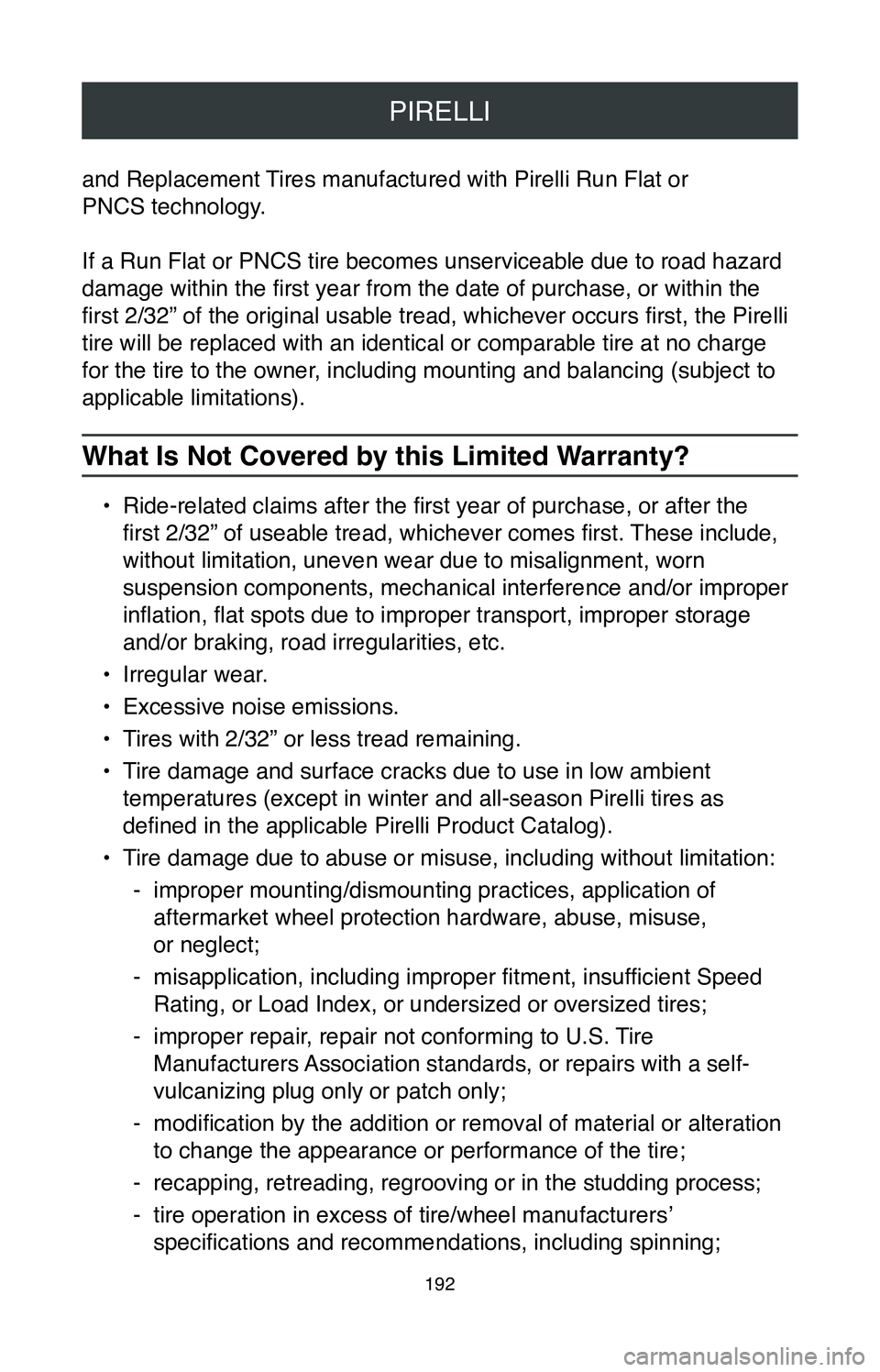
PIRELLI
192
and Replacement Tires manufactured with Pirelli Run Flat or
PNCS technology.
If a Run Flat or PNCS tire becomes unserviceable due to road hazard
damage within the first year from the date of purchase, or within the
first 2/32” of the original usable tread, whichever occurs first, the Pirelli
tire will be replaced with an identical or comparable tire at no charge \
for the tire to the owner, including mounting and balancing (subject to
applicable limitations).
What Is Not Covered by this Limited Warranty?
• Ride-related claims after the first year of purchase, or after the
first 2/32” of useable tread, whichever comes first. These include,
without limitation, uneven wear due to misalignment, worn
suspension components, mechanical interference and/or improper
inflation, flat spots due to improper transport, improper storage
and/or braking, road irregularities, etc.
•
Irregular wear.
•
Excessive noise emissions.
•
Tires with 2/32” or less tread remaining.
•
Tire damage and surface cracks due to use in low ambient
temperatures (except in winter and all-season Pirelli tires as
defined in the applicable Pirelli Product Catalog).
•
Tire damage due to abuse or misuse, including without limitation:
- improper mounting/dismounting practices, application of
aftermarket wheel protection hardware, abuse, misuse,
or neglect;
- misapplication, including improper fitment, insufficient Speed
Rating, or Load Index, or undersized or oversized tires;
-improper repair, repair not conforming to U.S. Tire
Manufacturers Association standards, or repairs with a self-
vulcanizing plug only or patch only;
- modification by the addition or removal of material or alteration
to change the appearance or performance of the tire;
-recapping, retreading, regrooving or in the studding process;
- tire operation in excess of tire/wheel manufacturers’
specifications and recommendations, including spinning;
Page 195 of 260
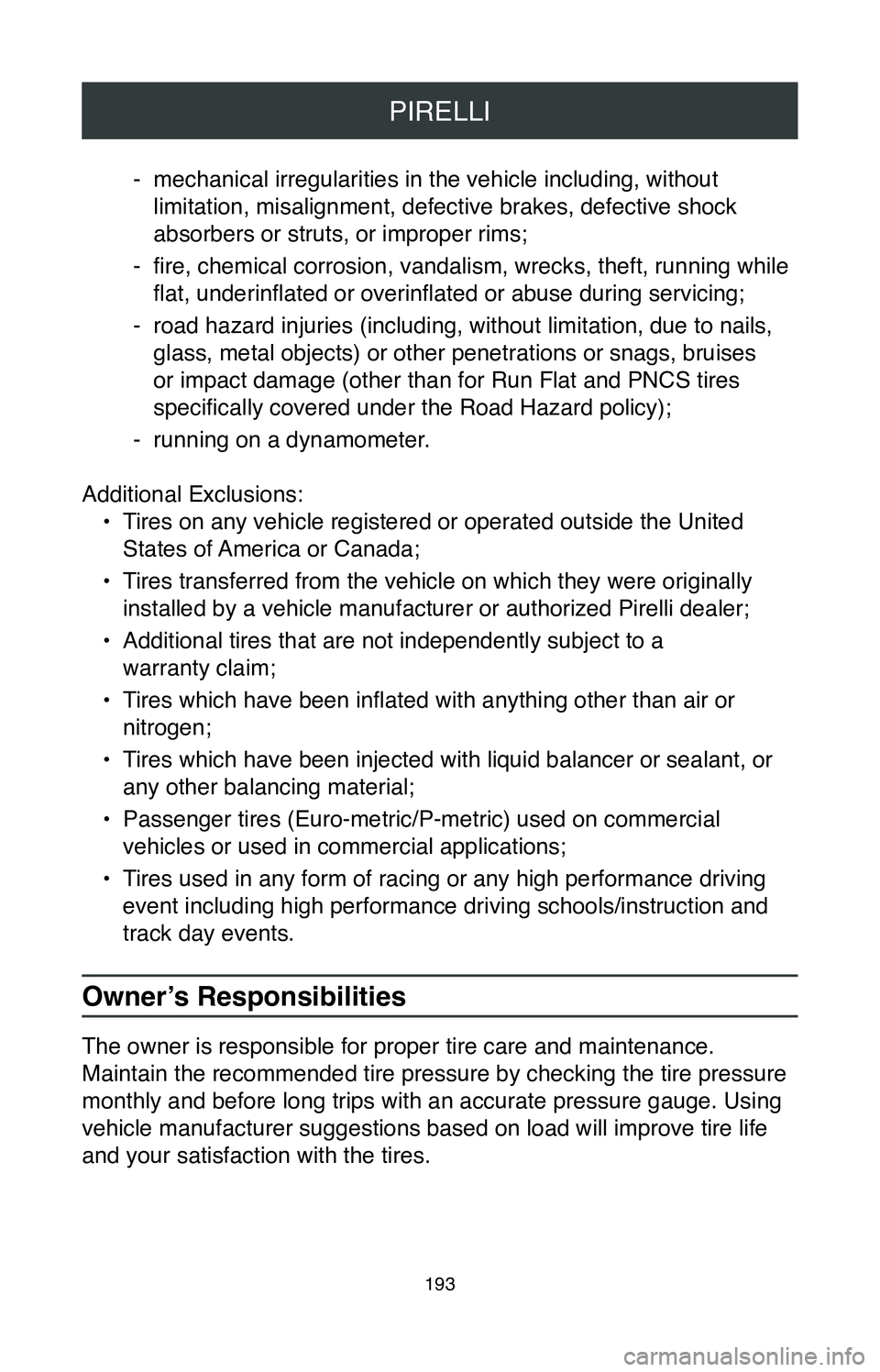
PIRELLI
193
-mechanical irregularities in the vehicle including, without
limitation, misalignment, defective brakes, defective shock
absorbers or struts, or improper rims;
- fire, chemical corrosion, vandalism, wrecks, theft, running while
flat, underinflated or overinflated or abuse during servicing;
- road hazard injuries (including, without limitation, due to nails, glass, metal objects) or other penetrations or snags, bruises
or impact damage (other than for Run Flat and PNCS tires
specifically covered under the Road Hazard policy);
-running on a dynamometer.
Additional Exclusions: •
Tires on any vehicle registered or operated outside the United
States of America or Canada;
•
Tires transferred from the vehicle on which they were originally
installed by a vehicle manufacturer or authorized Pirelli dealer;
•
Additional tires that are not independently subject to a
warranty claim;
•
Tires which have been inflated with anything other than air or
nitrogen;
•
Tires which have been injected with liquid balancer or sealant, or
any other balancing material;
•
Passenger tires (Euro-metric/P-metric) used on commercial
vehicles or used in commercial applications;
•
Tires used in any form of racing or any high performance driving
event including high performance driving schools/instruction and
track day events.
Owner’s Responsibilities
The owner is responsible for proper tire care and maintenance.
Maintain the recommended tire pressure by checking the tire pressure
monthly and before long trips with an accurate pressure gauge. Using
vehicle manufacturer suggestions based on load will improve tire life
and your satisfaction with the tires.
Page 199 of 260
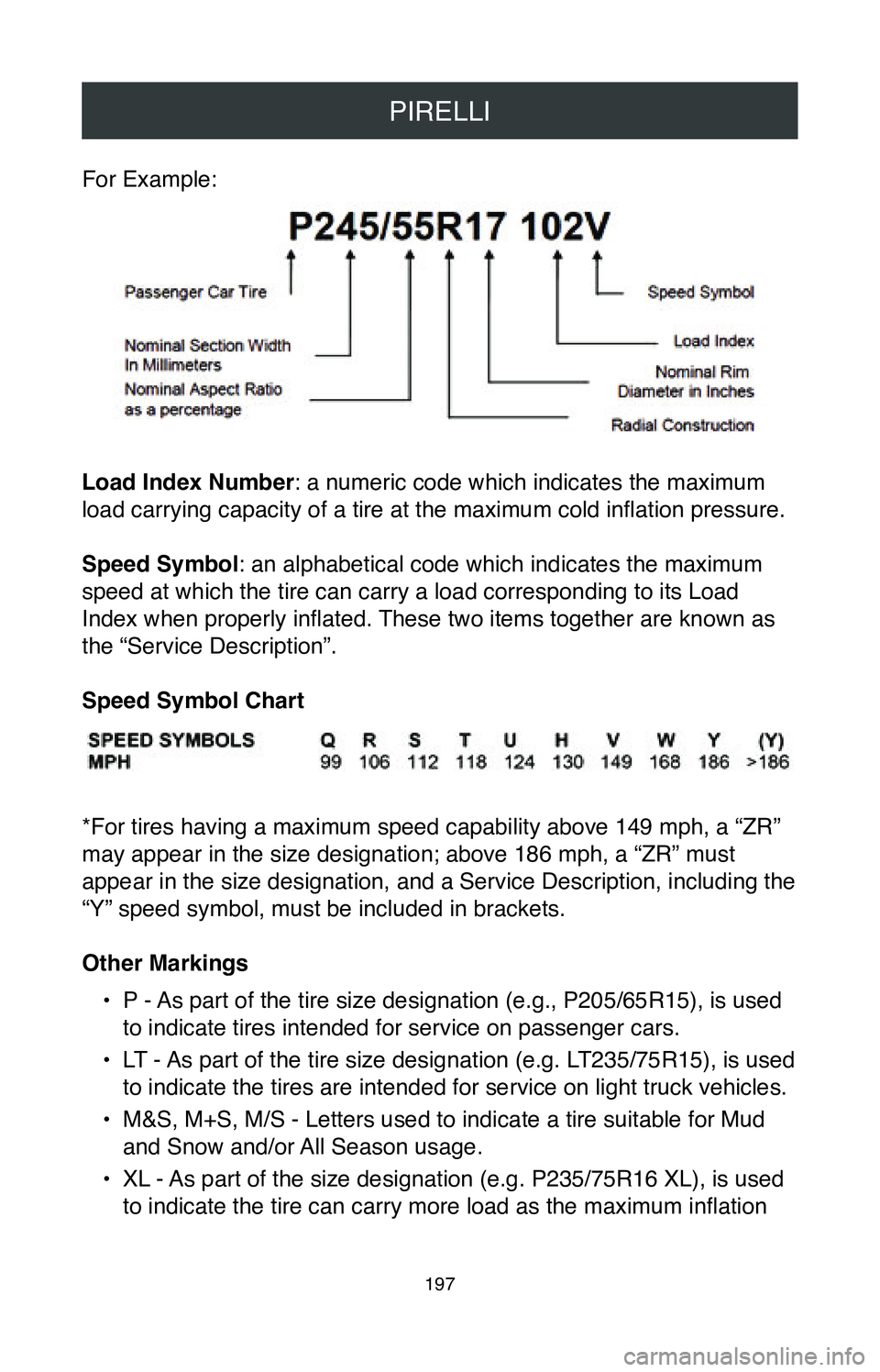
PIRELLI
197
For Example:
Load Index Number: a numeric code which indicates the maximum
load carrying capacity of a tire at the maximum cold inflation pressure.
Speed Symbol: an alphabetical code which indicates the maximum
speed at which the tire can carry a load corresponding to its Load
Index when properly inflated. These two items together are known as
the “Service Description”.
Speed Symbol Chart
*For tires having a maximum speed capability above 149 mph, a “ZR”
may appear in the size designation; above 186 mph, a “ZR” must
appear in the size designation, and a Service Description, including the\
“Y” speed symbol, must be included in brackets.
Other Markings
•
P - As part of the tire size designation (e.g., P205/65R15), is used
to indicate tires intended for service on passenger cars.
•
LT - As part of the tire size designation (e.g. LT235/75R15), is used
to indicate the tires are intended for service on light truck vehicles.
•
M&S, M+S, M/S - Letters used to indicate a tire suitable for Mud
and Snow and/or All Season usage.
•
XL - As part of the size designation (e.g. P235/75R16 XL), is used
to indicate the tire can carry more load as the maximum inflation
Page 200 of 260
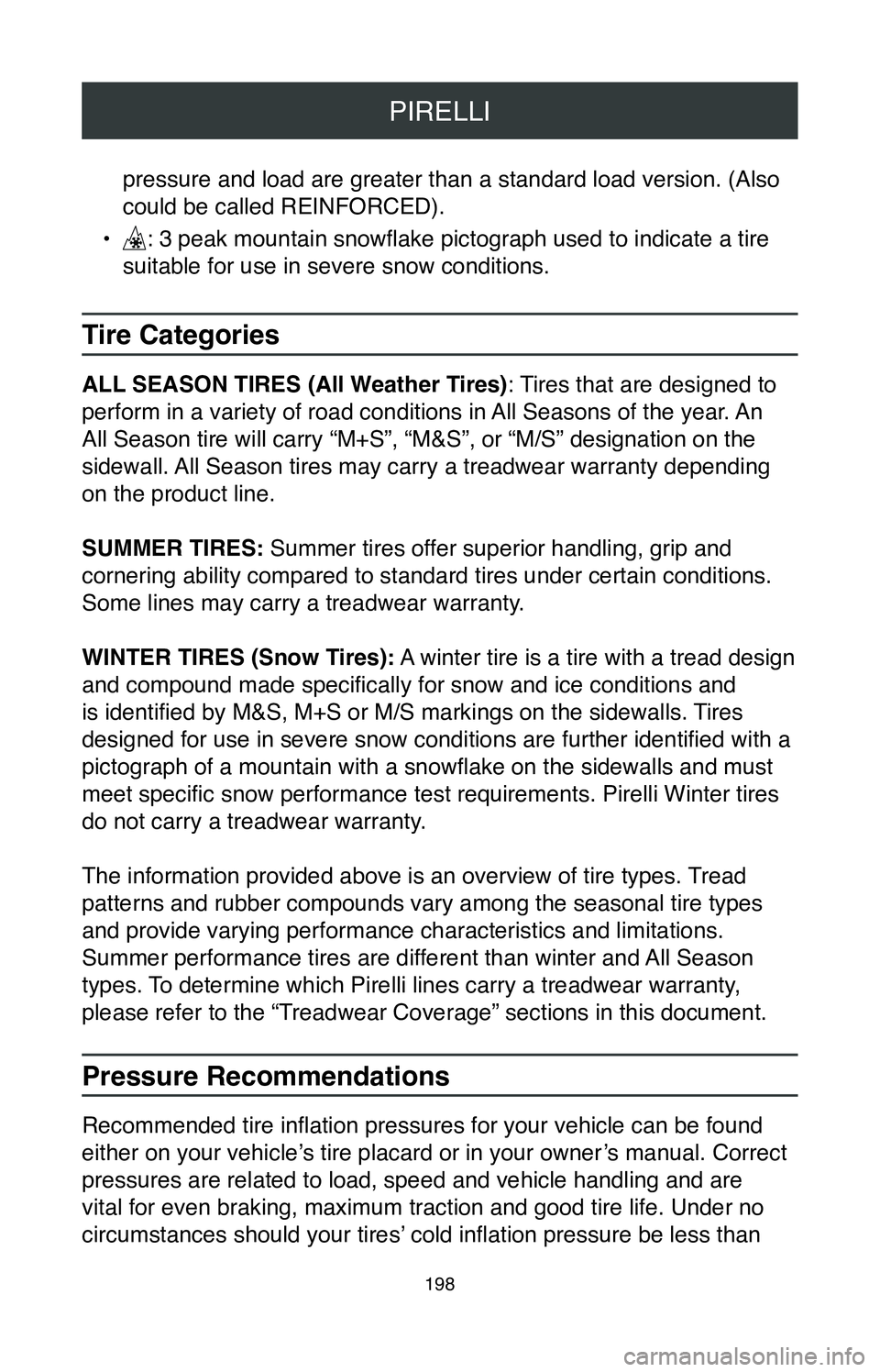
PIRELLI
198
pressure and load are greater than a standard load version. (Also
could be called REINFORCED).
•
: 3 peak mountain snowflake pictograph used to indicate a tire
suitable for use in severe snow conditions.
Tire Categories
ALL SEASON TIRES (All Weather Tires): Tires that are designed to
perform in a variety of road conditions in All Seasons of the year. An
All Season tire will carry “M+S”, “M&S”, or “M/S” desi\
gnation on the
sidewall. All Season tires may carry a treadwear warranty depending
on the product line.
SUMMER TIRES: Summer tires offer superior handling, grip and
cornering ability compared to standard tires under certain conditions.
Some lines may carry a treadwear warranty.
WINTER TIRES (Snow Tires): A winter tire is a tire with a tread design
and compound made specifically for snow and ice conditions and
is identified by M&S, M+S or M/S markings on the sidewalls. Tires
designed for use in severe snow conditions are further identified with a
pictograph of a mountain with a snowflake on the sidewalls and must
meet specific snow performance test requirements. Pirelli Winter tires
do not carry a treadwear warranty.
The information provided above is an overview of tire types. Tread
patterns and rubber compounds vary among the seasonal tire types
and provide varying performance characteristics and limitations.
Summer performance tires are different than winter and All Season
types. To determine which Pirelli lines carry a treadwear warranty,
please refer to the “Treadwear Coverage” sections in this document.
Pressure Recommendations
Recommended tire inflation pressures for your vehicle can be found
either on your vehicle’s tire placard or in your owner’s manual. Correct
pressures are related to load, speed and vehicle handling and are
vital for even braking, maximum traction and good tire life. Under no
circumstances should your tires’ cold inflation pressure be less than
Page 201 of 260
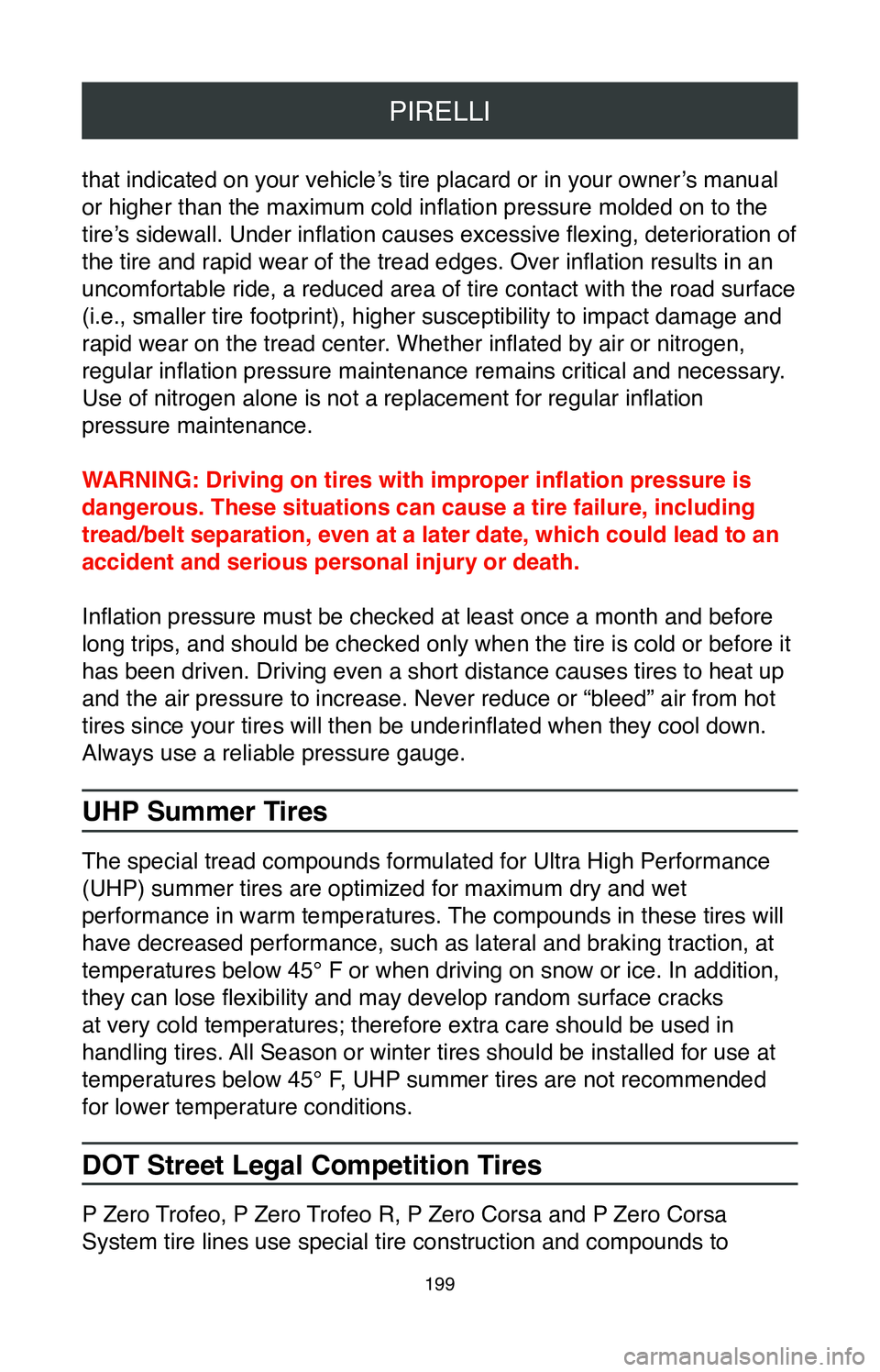
PIRELLI
199
that indicated on your vehicle’s tire placard or in your owner’s manual
or higher than the maximum cold inflation pressure molded on to the
tire’s sidewall. Under inflation causes excessive flexing, deterioration of
the tire and rapid wear of the tread edges. Over inflation results in an
uncomfortable ride, a reduced area of tire contact with the road surface\
(i.e., smaller tire footprint), higher susceptibility to impact damage and
rapid wear on the tread center. Whether inflated by air or nitrogen,
regular inflation pressure maintenance remains critical and necessary.
Use of nitrogen alone is not a replacement for regular inflation
pressure maintenance.
WARNING: Driving on tires with improper inflation pressure is
dangerous. These situations can cause a tire failure, including
tread/belt separation, even at a later date, which could lead to an
accident and serious personal injury or death.
Inflation pressure must be checked at least once a month and before
long trips, and should be checked only when the tire is cold or before i\
t
has been driven. Driving even a short distance causes tires to heat up
and the air pressure to increase. Never reduce or “bleed” air from\
hot
tires since your tires will then be underinflated when they cool down.
Always use a reliable pressure gauge.
UHP Summer Tires
The special tread compounds formulated for Ultra High Performance
(UHP) summer tires are optimized for maximum dry and wet
performance in warm temperatures. The compounds in these tires will
have decreased performance, such as lateral and braking traction, at
temperatures below 45° F or when driving on snow or ice. In addition,\
they can lose flexibility and may develop random surface cracks
at very cold temperatures; therefore extra care should be used in
handling tires. All Season or winter tires should be installed for use at
temperatures below 45° F, UHP summer tires are not recommended
for lower temperature conditions.
DOT Street Legal Competition Tires
P Zero Trofeo, P Zero Trofeo R, P Zero Corsa and P Zero Corsa
System tire lines use special tire construction and compounds to